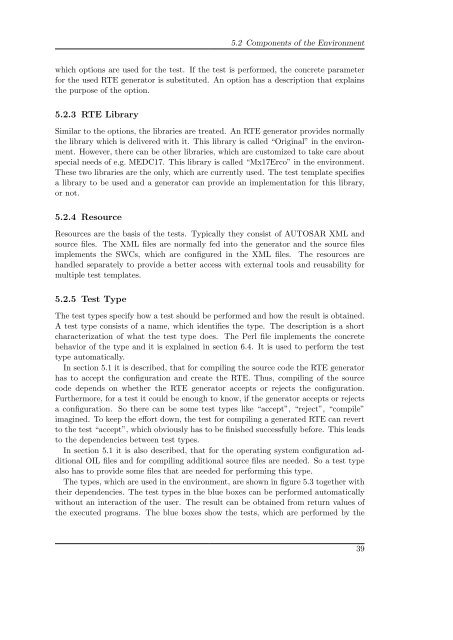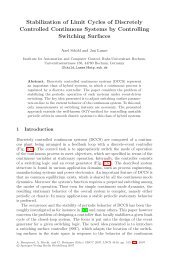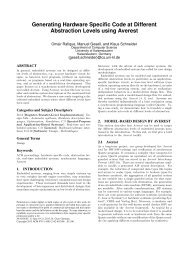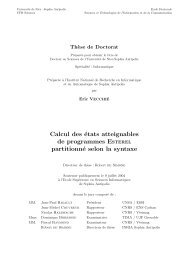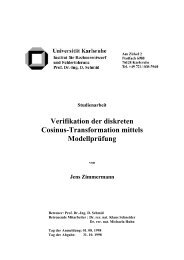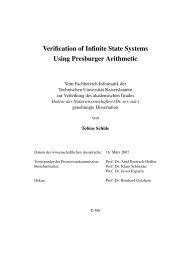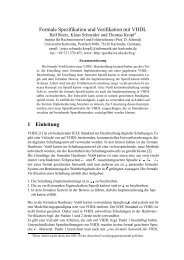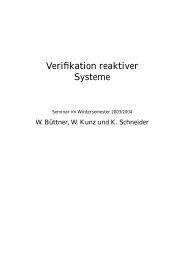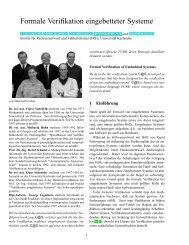Evaluation Environment for AUTOSAR-Autocode in Motor Control ...
Evaluation Environment for AUTOSAR-Autocode in Motor Control ...
Evaluation Environment for AUTOSAR-Autocode in Motor Control ...
You also want an ePaper? Increase the reach of your titles
YUMPU automatically turns print PDFs into web optimized ePapers that Google loves.
5.2 Components of the <strong>Environment</strong><br />
which options are used <strong>for</strong> the test. If the test is per<strong>for</strong>med, the concrete parameter<br />
<strong>for</strong> the used RTE generator is substituted. An option has a description that expla<strong>in</strong>s<br />
the purpose of the option.<br />
5.2.3 RTE Library<br />
Similar to the options, the libraries are treated. An RTE generator provides normally<br />
the library which is delivered with it. This library is called “Orig<strong>in</strong>al” <strong>in</strong> the environment.<br />
However, there can be other libraries, which are customized to take care about<br />
special needs of e.g. MEDC17. This library is called “Mx17Erco” <strong>in</strong> the environment.<br />
These two libraries are the only, which are currently used. The test template specifies<br />
a library to be used and a generator can provide an implementation <strong>for</strong> this library,<br />
or not.<br />
5.2.4 Resource<br />
Resources are the basis of the tests. Typically they consist of <strong>AUTOSAR</strong> XML and<br />
source files. The XML files are normally fed <strong>in</strong>to the generator and the source files<br />
implements the SWCs, which are configured <strong>in</strong> the XML files. The resources are<br />
handled separately to provide a better access with external tools and reusability <strong>for</strong><br />
multiple test templates.<br />
5.2.5 Test Type<br />
The test types specify how a test should be per<strong>for</strong>med and how the result is obta<strong>in</strong>ed.<br />
A test type consists of a name, which identifies the type. The description is a short<br />
characterization of what the test type does. The Perl file implements the concrete<br />
behavior of the type and it is expla<strong>in</strong>ed <strong>in</strong> section 6.4. It is used to per<strong>for</strong>m the test<br />
type automatically.<br />
In section 5.1 it is described, that <strong>for</strong> compil<strong>in</strong>g the source code the RTE generator<br />
has to accept the configuration and create the RTE. Thus, compil<strong>in</strong>g of the source<br />
code depends on whether the RTE generator accepts or rejects the configuration.<br />
Furthermore, <strong>for</strong> a test it could be enough to know, if the generator accepts or rejects<br />
a configuration. So there can be some test types like “accept”, “reject”, “compile”<br />
imag<strong>in</strong>ed. To keep the ef<strong>for</strong>t down, the test <strong>for</strong> compil<strong>in</strong>g a generated RTE can revert<br />
to the test “accept”, which obviously has to be f<strong>in</strong>ished successfully be<strong>for</strong>e. This leads<br />
to the dependencies between test types.<br />
In section 5.1 it is also described, that <strong>for</strong> the operat<strong>in</strong>g system configuration additional<br />
OIL files and <strong>for</strong> compil<strong>in</strong>g additional source files are needed. So a test type<br />
also has to provide some files that are needed <strong>for</strong> per<strong>for</strong>m<strong>in</strong>g this type.<br />
The types, which are used <strong>in</strong> the environment, are shown <strong>in</strong> figure 5.3 together with<br />
their dependencies. The test types <strong>in</strong> the blue boxes can be per<strong>for</strong>med automatically<br />
without an <strong>in</strong>teraction of the user. The result can be obta<strong>in</strong>ed from return values of<br />
the executed programs. The blue boxes show the tests, which are per<strong>for</strong>med by the<br />
39


